These three rags for the richest are for people who aren’t coy about their cash or bashful about their bankfuls. Drive any of them through town with the roof folded, and you’ll attract gazes, glances and gestures – some not at all complimentary. Pop the roof up, though, and you’re back in your own world, away from the disdainful eyes of the masses.
Aston Martin’s Virage Volante attracts the most attention. It’s a less familiar sight than either the Jaguar or the Mercedes, and it looks big and imposing to boot. And so is the pile of cash required to
put one onto your driveway. Virage ownership demands a hefty £147,862, making the Benz 500SL look cheap at £74,400, and the XJS Convertible an absolute steal at £52,500. Why, when cost is no object with these open class GTs, have we lined up a 1993 Mercedes-Benz 500SL R129 when we could have gone for the dearer 600SL? The reason is that we are looking for pure driving pleasure from our tip-top drop-tops, and we reckon the V8 SL is a better, more enjoyable, drive than the V12.
STYLING, ENGINEERING
That it looks imposing is about the kindest thing you can say of the Virage Volante. Like its predecessor, the V8 Volante, the Virage looks as if it weighs 10 tons (it feels like it does, too, but we’ll come to that later). There’s no part of the Virage’s extensive body that catches the eye pleasingly, no detail that takes the breath away. From the back it looks plain ugly – roof up, the car looks far too narrow for its height, and then there’s that ugly belly pan that hides the exhaust system.
Taking a tin-opener to the XJS in 1989 quietened down many of the Jaguar coupe’s critics. Park an XJS Convertible, preferably painted British racing green and with a tan interior, in the sunshine by a trad village green and it looks impressive and graceful. Though big, it’s much more svelte and finely proportioned than the Aston. The Jaguar has plenty of that element rarely found on cars these days – chrome plating – which helps give the car a classy old Brit look. Pity about the body-coloured bumpers, though. That said, the old rubber-covered items were pretty ugly anyway, and the new ones do bring the car more up to date. Jaguar engineers could have put more effort into incorporating the front driving lights into the moulding, rather than just hanging them like Halfords-sourced add-ons.
There’s not really a specific part of the Benz SL that’s exquisitely turned, either. But unlike the Aston, the SL is beautiful as a whole. It’s not flash but, as with a beautifully tailored suit, you know you’re looking at something special.
To find the special part of the Aston you have to lift its bonnet, for underneath lives one of the world’s most aesthetically pleasing powerplants. Assembled by hand, the Virage’s all-alloy quad-cam 5.3-litre V8 bristles with beautifully machined surfaces, neatly routed plug leads and wiring, and high quality fasteners. It should look good – it costs Aston £18,000 to make. Power output is 310bhp at 6000rpm with 340lb ft of torque at 3700rpm. These figures are fed through a new-for-1993 four-speed autobox.

XJS understeers on the limit. Car is quick when driven neatly, though. Jag interior is comfortable and classy. Ergonomics still not perfect.

Mercedes-Benz R129 is wieldy and inspires huge confidence. Belies its size and mass. R129 500SL cabin superbly designed, but lacks exclusivity of British cars’.

Dynamically, Aston is a let-down. Cornering hard can be worrying. Attractive dash undermined by Ford-sourced parts and shoddy finish.
The military organisation of the Virage’s boiler room makes the Jaguar’s look like an explosion in a spaghetti factory. Jaguar has tried to hide some of the mess between the V12’s cylinder banks with a plastic cover. What’s gone is not forgotten, though, as there’s still so much disorder. Cluttered it may be, but the XJS’s motor is still one of the world’s most refined V12s, and all the better for being punched out to 6.0 litres. Power is now 308bhp at 5350rpm and there’s 355lb ft of torque at 2850rpm. More important still is the gearbox that this power is channelled through. The new XJS has a four-speeder, so at last it’s possible to exploit its engine properly.
The 500SL’s V8 is typical Mercedes fare: neat, orderly, but not an inspiring sight for the oily-fingered enthusiast. Good news for the power- junkies is that the SL pulls the hardest punch of our un-thrifty threesome, giving 326bhp at 5500rpm, though its figure of 332lb ft at 4000rpm makes it the least torquey here.
PERFORMANCE
The fruit of engine builder Roy Robarts’s craftsmanship is wasted in the Virage. His lovingly assembled V8 just hasn’t the power to pull 4400lb of Volante along at anything other than a relatively lethargic pace. The journey to 60mph takes 7.8sec, and the Aston’s top speed (roof up) at the Millbrook test track’s bowl is 145.6mph. The engine’s note promises action – it sounds wonderful, the most tuneful here – but doesn’t deliver. The only time you’re taken aback by the Virage’s performance is when you start it up. Our car’s cold idle was set at 2000rpm, which meant drama in the multi-storey car park unless you kept a firm foot on the brakes. Even when warm, the Virage requires restraining in traffic. Like both rivals, the Aston’s autobox has sport and normal settings. You’ll want to select sport mode most of the time, as in the standard setting progress is depressingly torpid. Annoyingly, each time you switch off the engine the sport mode is switched off with it, so you have to press the button (from a Ford Granada) to get it back again. Why not use a rocker switch?
![]()
Familiar Jag V12 now has 6.0 litres. Coupled to new four-speed autobox, its power is easily accessible.
![]() Mercedes engine is, with 5.0 litres and 326bhp, both the smallest and the most powerful of the three.
Mercedes engine is, with 5.0 litres and 326bhp, both the smallest and the most powerful of the three.
![]() Quad-cam all-alloy Aston V8 looks and sounds wonderful. Each engine is built by hand and costs £18,000.
Quad-cam all-alloy Aston V8 looks and sounds wonderful. Each engine is built by hand and costs £18,000.
We rarely used the economy mode on the Benz’s transmission either, but for a different reason. With around 500lb less weight than the obese Aston and 18 more horses, the 500SL is in a different performance league. It doesn’t sound as wonderful as the AM’s V8, but its ability to fling the SL to 60mph in 6.8sec more than makes up for that. It’s such a willing motor, too, which is why it’s hard to resist hitting sport mode and getting the rev-counter waving like a drowning man.
One of the world’s most complicated catalytic converter set-ups robs the Jaguar’s V12 of some of its roar, but it still sounds great. The new, sorely needed, four-speed box means that not only do you get incredibly smooth gearchanges, but you can now overtake in the XJS without wondering at which point in the manoeuvre the power will arrive. A 0-60 time of 7.6sec for the Jag may barely better the Aston’s figure, but where it counts – on the road – the XJS feels far quicker, far more responsive.
There’s one area in which the Aston beats its German and British rivals, and that’s in the drinking contest. The Virage supped the unleaded at an average of 12.4mpg in our hands, dropping as low as 10.1mpg for one tankful. The Jaguar was almost as greedy, drinking a gallon every 13.1 miles. Those saving petrol coupons will find the 500SL a bit of a disappointment: it managed an exceptional 18,4mpg, rising on one occasion to an almost politically correct 20.6mpg.
| ACCELERATION (sec) | 0-30 | 0-40 | 0-50 | 0-60 | 0-70 | 0-80 | 0-90 | 0-100 | 30-80 |
| Aston Martin | 3.2 | 4.4 | 6.1 | 7.8 | 10.2 | 13.0 | 16.2 | 19.8 | 9.8 |
| Jaguar | 2.9 | 4.2 | 5.7 | 7.6 | 9.5 | 12.0 | 14.9 | 18.3 | 9.1 |
| Mercedes-Benz | 2.9 | 3.9 | 5.3 | 6.8 | 8.4 | 10.5 | 13.2 | 15.9 | 7.6 |
| SPEEDS IN GEARS (mph) | First | Second | Third | Fourth | |||||
| Aston Martin | 66 | 113 | na | 145.6 | |||||
| Jaguar | 47 | 79 | 118 | 144.9 | |||||
| Mercedes-Benz | 43 | 74 | 116 | 157.3 | |||||
| FUEL CONSUMPTION MPG | Test | Urban | 56mph | 75mph | |||||
| Aston Martin | 12.5 | 12.1 | 25.8 | 20.4 | |||||
| Jaguar | 13.1 | 13.2 | 26.4 | 22.6 | |||||
| Mercedes-Benz | 18.4 | 17.7 | 29.4 | 24.6 | |||||
ROADHOLDING, HANDLING
These are grand tourers, not sports cars – but the 500SL doesn’t seem to realise this. It’s neither light nor narrow, but it feels as if it’s both. And it’s so wieldy. You can throw the SL around as if it were a nippy sportster. There’s an enormous feeling of security, too, thanks in part to the traction-control system which does a great job of preventing nasty moments. Too good a job, in fact. The Benz’s chassis is so taut and responsive, so free from flex and shake, that you wish that the driver was given a bit more responsibility for looking after things out back. As we’ve come to expect on M-Bs, the steering is short on feel, robbing the driver of detailed information.
It has taken Jaguar 18 years to get the XJS to where it is now, and where it should always have been. Most important change to the ragtop is the addition of a cross-brace under the engine. This was done last year, but with the latest XJS there’s even more reinforcement on the chassis. It comes as a by-product of the new 2+2 seating arrangement. The extra perches are formed out of a cartridge-like sheet metal assembly that incorporates the seat-belt mounts, and this whole structure acts as a brace for the rear of the car. There’s now so little body flex – in the unbraced XJS convertible you could see two tax discs on the screen over bumpy roads – that Jaguar has made the optional sports- suspension package available on its big softy.
We’d recommend ticking the box for this option. You’d be surprised how easy it is to hustle the Jag along at a good crack. Sure, it’s not as fleet as the SL, nor does it feel as secure, but even with stiffer springing the car rides so well that it can laugh at bumps.
The steering, another XJS weak point, is now by ZF, and has much more feel than before: it’s certainly no worse than the Merc’s. While the 500SL R129 requires electronic tricks to stop its tail from wagging, the XJS’s stays put, instead it’s the front end of the car that misbehaves. The Jaguar does not relish very late braking or harsh steering inputs. Drive like this and the front will wash out. Drive it smoothly, though, and it’ll glide you around without fuss.

Ragtop XJS is much more rigid than before, and still rides superbly. Jag boot adequate, but spare wheel and fuel tank encroach awkwardly.

Traction control makes Mercedes easiest of the three to drive quickly. 500SL offers sizeable, sensibly shaped compartment for luggage.

Boot is a joke for a car this size. A couple of soft bags is Aston’s limit. Volante is tricky on twisty roads. Steering is too high-geared, nervous.
Last and – disappointingly – very much least, we have the Aston. An Aston Martin should be an experience. Ours was. A bad one. The Virage bounced, lurched, creaked and groaned so much that we reckoned something was wrong. Sure enough, the collett on the front offside damper on which the coil spring sits, had broken.
Even when fixed, though, the Volante would still bottom out, shake its scuttle, and feel dead. It pitches and floats so much that holding your chosen line, especially on cresting roads, isn’t easy. Even less so than it could be, because the steering is too high-geared, making subtle corrections tricky. We found ourselves taking bends 50p-piece style.
It’s such an effort to extract this mediocre performance that you’re put off from indulging in spirited driving. While the SL is quite happy to be a sports car if asked, and the XJS will play if the game’s not too rough, the Volante is best kept to boulevard work: its ride is comfortable enough, and it’s mainly the creaking of the fittings that makes you aware of any bumps.
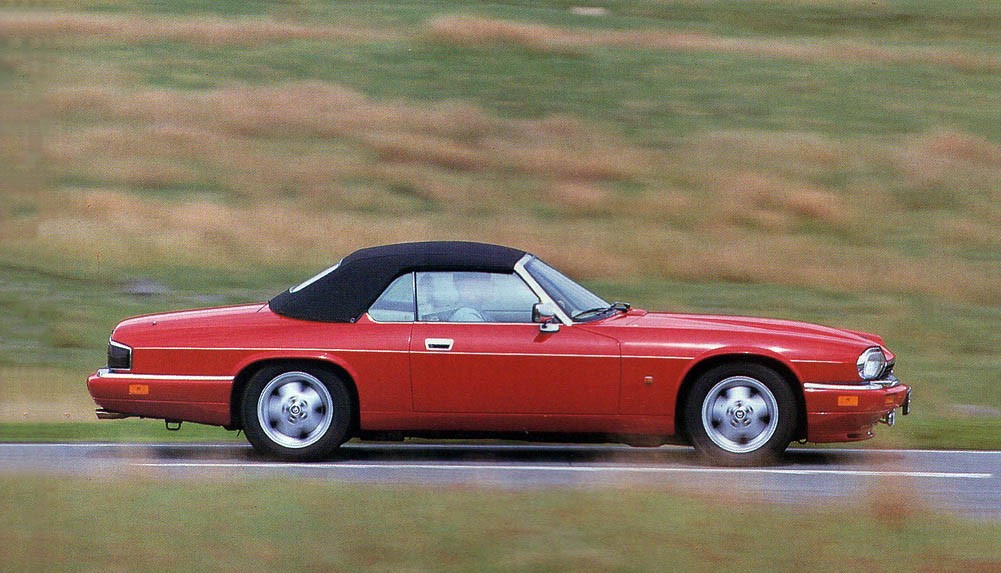
Latest revamp has at last silenced XJS’s critics. Car now almost graceful. Chrome looks dated but elegant.
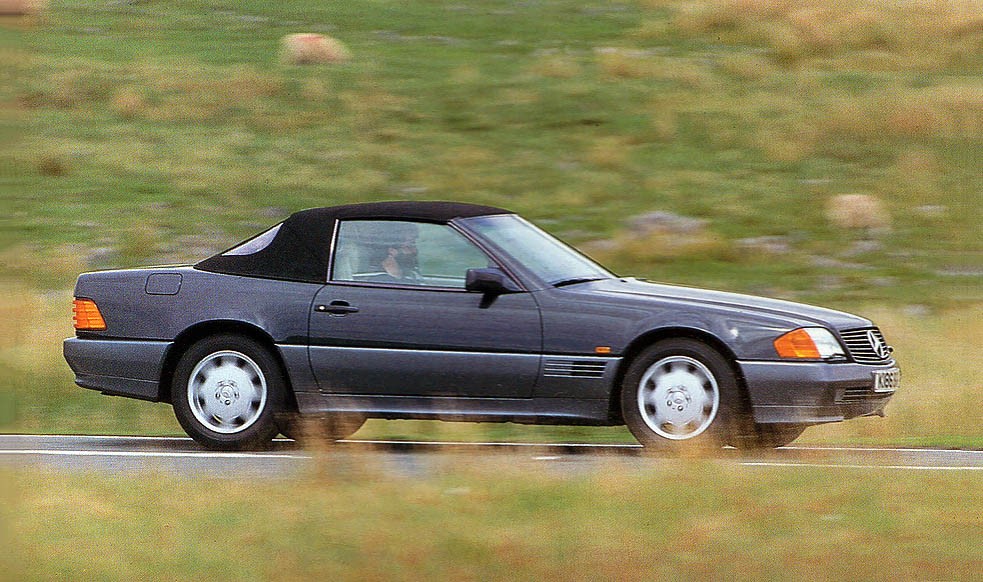
Mercedes is much more modern than its rivals – and looks it, too. Shape is clean, free from adornment.
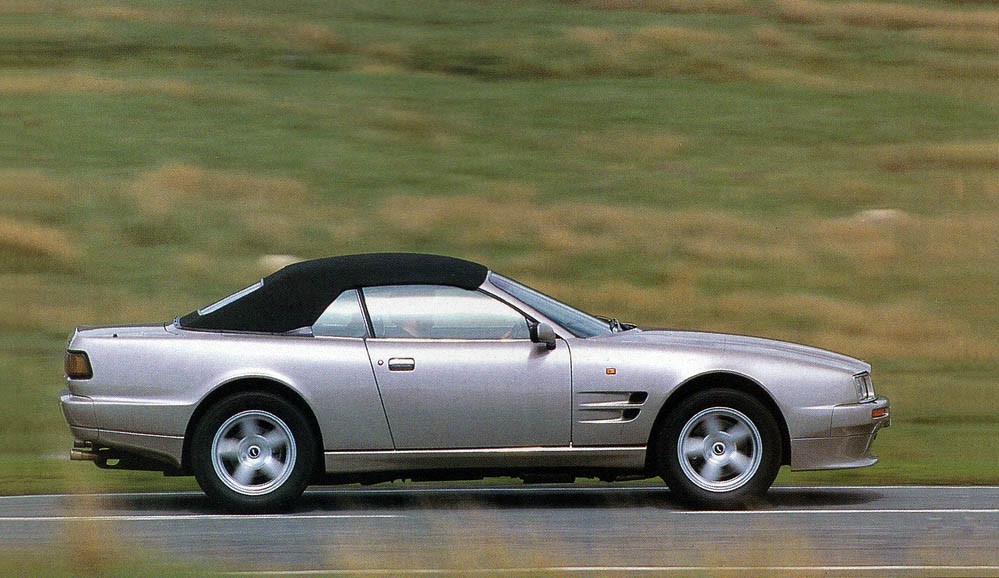
Brawny Aston is now an anachronism. Car is unsubtle and unsophisticated, and feels far too heavy.
ACCOMMODATION, COMFORT
To misquote DR Johnson: a man who is bored with watching an SL’s hood system in operation is bored with life itself. Everything from the batphone-like switch that activates it, to the metal cover that rises and drops to accommodate the furled hood, is testimony to the level of thought that has gone into the SL. The hood’s plastic rear window and exposed frame are a little disappointing, but as compensation you get an excellent hardtop for winter use. The R129 500SL is, as are the other two cars, quiet at speed with the hood up – and it keeps out the rain, which is a feat the Aston can’t quite match.
The rear seats in the Benz are really only good for whizzing the kids down to McDonalds, but they fold up very neatly so that the space can be used for stowage. The boot is reasonably large, and sensibly shaped. The same can’t be said of the Virage’s. Two adults would have real trouble fitting weekend baggage in the car, and they’d have no hope if it wasn’t soft luggage. To compensate, the Aston has more room for folk in the rear, but it’s still only suitable for those under long- trouser age. The hood just requires the touch of a button to operate, except that on ours one of the rear quarterlights needed a helping hand.
The Jaguar’s new rear seats are more use for stowing kit than people, but as in the other two cars, the kids are all right for short trips. The boot is an awkward shape, but is big enough to carry weekending gear. The hood is beautifully trimmed and little of its frame is visible, and the rear window is glass. Manual labour is needed to lock and unlock its catches, but only the most couch-ridden drivers will curse it.
All three convertibles are comfortable long-distance tourers, so no sore backs on the way to Cannes – besides, any aches picked up in the Jaguar or Aston can be walked off at the frequent fuel stops. All three have electrically adjustable seats, and the Benz and Aston’s steering columns adjust electrically in both planes.
The XJS’s column has lost its ability to telescope – because, Jaguar claims, the airbag prevents it. The real reason is that the new bought-in column doesn’t have that feature.
DRIVER APPEAL
More brickbats for the Aston Martin here. We’ve no gripe about the company using sourced parts from within the Ford family – better that than no Aston Martin at all – but what grates is the choice of parts. That switch for the autobox’s mode selection, for example. Not only is it a daft type to use, but you can’t see its indicator light in daylight. The instruments – not from Ford, but bought in – have poorly scripted numerals and shouldn’t be seen on anything other than a kit car. The American-type column stalk has a nasty, brittle action, and the gear selector is appalling. The position of the flickering indicator gives barely a clue of what gear you’re actually in, and the lever itself has a crude, sticky action and needs a hefty tug to get first gear.
The Virage is almost saved by the smell. There’s no doubt that this car’s interior trim was once treasured by a cow. There’s acres of the stuff – almost too much – wrapped and rolled over the dashboard, seats and doors. Trouble is, the richness of it all just emphasises the cheapness of the switches and controls.
Step inside the Benz and you’re in familiar territory. Usual Benz controls, usual quality. But not quite. The moulded plastic seat back had come loose on the driver’s chair, and wouldn’t be re-attached. There’s no luxurious whiff of hide, no carriage-clock instruments, but like the outside of the car, the interior is so cleanly designed, so well integrated that it seduces anyway.
There’s engineering to enjoy, too. The gearshift shows Aston how it should be done.
It shows everyone how to do it, in fact. Third/fourth changes require just a diagonal flick, and the lever always snicks through its gate with a wonderful action.
The Jaguar’s cabin is very good, too. Sure, there are areas to criticise – the ergonomics, for example, are a bit wayward – but the creation of an English gentleman’s grand tourer has been done in good taste, at least (which you can’t really say of the Aston). You get a great feeling of contentment in the Jaguar; it always feels like a nice place to be.
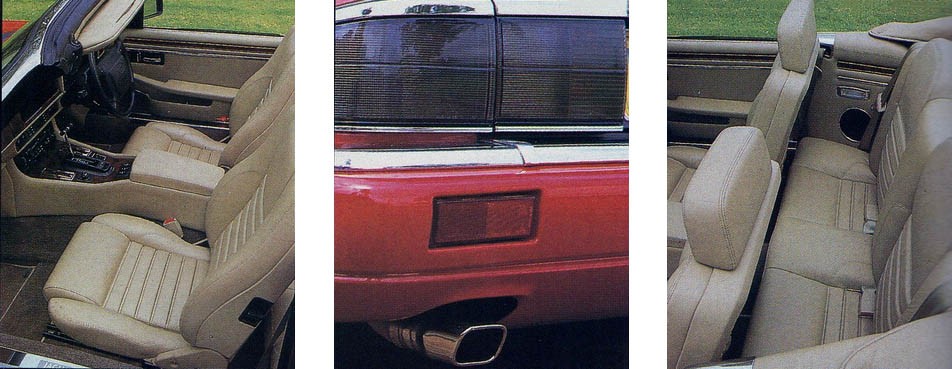
XJS seats traditional but comfy. Bumpers and tail pipes are new. 2+2 configuration is unrealistic.
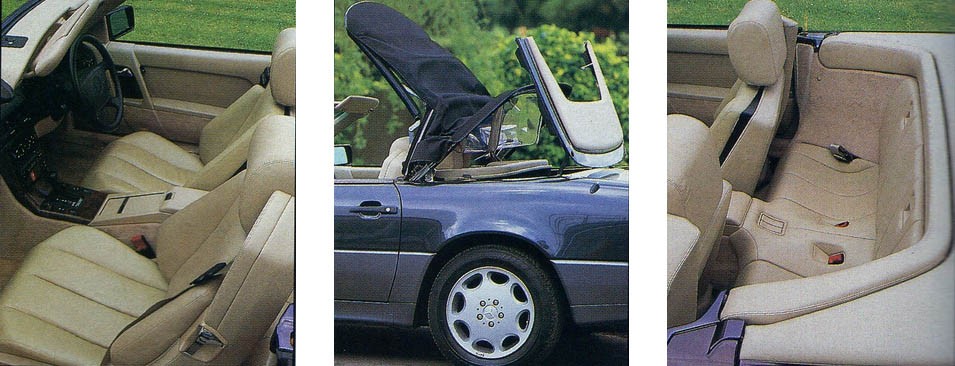
Plenty of lateral support in Mercedes-Benz R129. Hood offers effortless operation. Rear ‘seats’ fold to enlarge boot.
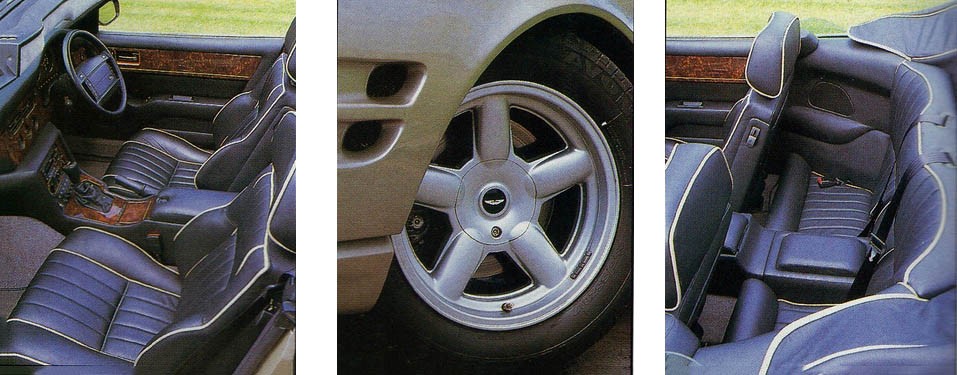
Acres of leather dominate cabin. Volante big on macho detailing. Aston’s rear seats almost viable.
Since much of Britain’s sunshine occurs in winter, the ability to keep brave open-top fans warm is important. Both Aston and Jag have front seat heaters as standard, and on the Merc they’re a £428 option. Mind you, roof down, the SL’s cockpit stays bluster-free, unless the ferociously efficient heater is on full.
Once you’ve mastered the XJS’s heater, it’ll keep you comfortable. The Aston, too, will cruise topless at the ton without its occupants being sucked out of their chairs – and they’ll be warm, as well.
CONCLUSION
Thank Henry that Ford owns Aston Martin. If it didn’t, there’d be black armbands worn in this office. For without Ford, there’d be no DB7 to look forward to – and we’d have to try to find something to be optimistic about in the present range of cars.
And that would be difficult. Thankfully, the DB7 promises much, so we can look at the Volante for what it is – the last of a dying breed – without getting too upset about it. If you want the Aston badge badly, wait for the DB7.
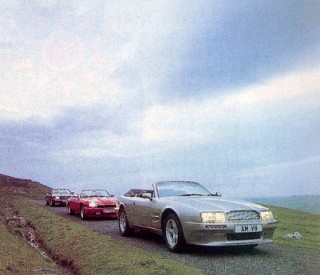
The XJS convertible, too, is a car that is perilously close to the end of its life. But Jaguar, by rectifying most of the car’s old faults, has managed to bring its coupe up to a ’90s standard. And still the company can charge a not unreasonable £52,900 for the car. If we were to dress up in grey suits and start considering value for money, we’d have to think seriously about awarding the Jaguar top spot on the rostrum. It’s a better car than the Aston on all counts, and it’s much, much cheaper. The Aston Martin comes last whichever criterion you use: it’s dreadful value, and it doesn’t give pleasure.
But we’re looking for that special contentment when all rational thoughts about value fly out of the open cockpit.
The Jaguar is a fine car, but we pick the 500SL. It fills its brief so comprehensively. It’s practical, safe and durable, but it’s also fast, handles well and is beautifully wrought. It would be the best long-term ownership proposition and, in the meantime, it’s a joy both to drive and to behold.
| SPECIFICATIONS | |||
| CAR | ASTON MARTIN | JAGUAR | MERCEDES |
| ENGINE | |||
|
Configuration Capacity (cc) Bore (mm) Stroke (mm) Compression (to one) Valve gear Aspiration Power (DIN/rpm) Torque (DIN/rpm) Power-to-weight ratio |
V8 5340 100.0 85.0 9.5 Dohc, 32-valve Fuel injection 310bhp/6000 340lb ft/3700 158bhp per ton |
V12 5994 90.0 78.5 11.1 Sohc, 24-valve Fuel injection 308bhp/5350 355lb ft/2850 158bhp per ton |
V8 4973 96.5 85.0 10.0 Dohc, 32-valve Fuel injection 326bhp/5500 332lb ft/4000 188bhp per ton |
| TRANSMISSION | |||
| SPEED | Four-speed | Four-speed | Four-speed |
| TYPE | Ford automatic | GM automatic | MB automatic |
| Ratios (mph/1000rpm) | |||
|
First |
2.45 (9.3) |
2.48 (7.9) |
3.87 (7.2) |
| Second | 1.45 (15.8) | 1.48 (13.2) | 2.25 (12.4) |
| Third | 1.00 (22.9) | 1.00 (19.6) | 1.44 (19.3) |
| Fourth | 0.69 (33.2) | 0.75 (26.1) | 1.00 (27.8) |
| Final-drive ratio (to one) | 3.54 | 2.88 | 2.65 |
| CHASSIS AND BODY | |||
| Construction | Steel chassis, aluminium body | Steel monocoque | Steel monocoque |
| Drag factor | Cd 0.29 | Cd 0.29 | Cd 0.33 |
| Front suspension | Double wishbones, coils, anti-roll bar | Double wishbones, coils, anti-roll bar | Double wishbones, coils, anti-roll bar |
| Rear suspension | De Dion, radius arms, Watt’s linkage, coils | Lower wishbones, driveshafts as upper link, coils | Multi link, coils, anti-roll bar |
| Steering | Rack and pinion | Rack and pinion | Recirculating ball |
| Type | Power-assisted | Power-assisted | Power-assisted |
| Turns, lock to lock | 2.5 | 2.5 | 3.0 |
| Turning circle (ft) | 45.9 | 42.7 | 42.0 |
| Wheels | 8.0×17 | 7.0×16 | 8.0×16 |
| Tyres | 255/55ZR17 | 225/60ZR16 | 225/55ZR16 |
| Brakes, type | Discs all round, ventilated at front, | Discs all round, ventilated at front, | Discs all round, ventilated at front, |
| Safe | ABS | ABS | ABS |
| DIMENSIONS (in) | |||
| Wheelbase | 102.8 | 102.0 | 99.0 |
| Front track | 59.5 | 58.6 | 60.4 |
| Rear track | 61.0 | 59.2 | 59.9 |
| Overall length | 186.8 | 189.8 | 176.0 |
| Overall width | 73.1 | 74.1 | 71.3 |
| Fuel tank capacity (gal) | 24.9 | 18.0 | 21.1 |
| Kerb weight (lb) | 4400 | 4377 | 3894 |
| CABIN DIMENSIONS (in) | |||
| Front headroom (max/min) | 38.5/na | 35.7/na | 36.0/na |
| Front legroom (max/min) | 44.0/37.0 | 44.3/37.0 | 45.0/36.0 |
| Rear headroom | 35.0 | 34.0 | 33.0 |
| Front shoulder room | 56.0 | 56.5 | 56.0 |
| Rear shoulder room | 48.0 | 46.0 | 42.0 |
| Luggage capacity (cu ft) | 5.47 | 8.99 | 9.35 |
| STANDARD EQUIPMENT | |||
| Anti-lock brakes | Yes | Yes | Yes |
| Air-conditioning | Yes | Yes | £2346.65 |
| Leather upholstery | Yes | Yes | Yes |
| Cruise control | Yes | Yes | £360.31 |
| Electric front seats | Yes | Yes | Yes |
| Heated front seats | Yes | Yes | £428.37 |
| Alloy wheels | Yes | Yes | Yes |
| Airbag | Yes | Yes | Yes |
| SERVICING | |||
| Cost (frequency) | £495.00+parts (6000) | £65.00 (1000) | No fixed cost (3000) |
| £585.00 (12,000) | £315.00 (7500) | No fixed cost (8000) | |
| £495.00 (18,000) | £401.00 (15,000) | No fixed cost (12,000) | |
| Number of UK dealers | 10 | 93 | 135 |
| 1993 UK TOTAL COST (including car tax and VAT) Price without extras | £147,862 | £52,900 | £74,400 |
| GUARANTEE | 24 months/unlimited mileage | 36 months/60,000 miles | 12 months/unlimited mileage |





